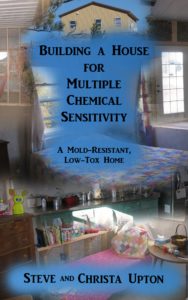Moisture, condensation, & mold in walls–why does it happen?
It’s of such concern because it can remain hidden for many years, slowly destroying walls, houses, & people’s health.
The most obvious reason for moisture in walls is leaks. Leaks can come from water pipes, improperly installed windows, improperly installed flashing around features such as skylights and chimneys, holes in siding, flooding, and holes in roofing.
Another cause for moisture in walls is condensation.
Regarding how & when condensation may become a problem, the number of variables makes things crazy-complicated. It depends on:
- Siding/cladding. Is it breathable? But if it is breathable, this also means it is a reservoir cladding, which means it holds rainwater. Reservoir cladding needs special consideration because of capillary transport, diffusion, & solar vapor drive. https://buildingscience.com/documents/information-sheets/reservoir-claddings
- The presence or absence of rainscreen construction. It seems to me that reservoir cladding is pretty risky with no rainscreen. But I’m not sure, & I also have questions about rainscreens that I have not been able to find answers to, such as: Do rainscreens depend on dryness outside to work? How quickly do they allow wall cavities to dry out? What if the ground where they drain is damp? Should something like French drains be installed below rainscreen gaps? Can they let in humidity, & as my friend mentioned–dirt, too? Dirt is mold food.
- Framing & rainscreen (if using rainscreen construction) materials. Do they create thermal bridges (metal)? Are they mold food (wood)? Maybe plastic (more self-insulating than metal; less susceptible to mold than wood) is best for rainscreen furring strips, but I don’t know.
- The presence or absence of vapor barriers in walls. I wrote a lot about this in our book & why I am not convinced of their usefulness, although reservoir cladding with rainscreens may benefit from a vapor barrier IF the vapor barrier is also a drainage plane. Honestly, there is so much conflicting information out there, it’s hard to say. But, there may be more than one way to skin a cat & still not end up with mold. (Odd mixed metaphor, sorry. LOL)
- Insulation type. Each type of insulation has different properties regarding water–absorbing or repelling, releasing or retaining, letting escape/drip off or trapping.
- Insulation sufficiency. This is one thing most people agree on: in a house that one wants to heat & keep warm, insufficient insulation causes heat loss & high risk of condensation.
- Interior wall materials.
- Presence or absence of interior paint. A wall painted with vapor-retarding paint will breathe less than a plain plaster wall.
- Presence or absence of wallpaper. Vinyl wallpaper in hot climates and houses with reservoir cladding is particularly associated with mold growth, because hot, humid air from outside can come through the wall and condense on the cold (air conditioned) backside of the vinyl wallpaper, causing mold growth.
- Climate, including temperature, humidity, rainfall, temperature swings, days of sunlight, and possibly elevation.
- Ventilation & humidity levels in the home.
- Wide temperature differences between day & nighttime. (which can result in condensation, because humidity is relative to temperature. A sudden drop in temperature will increase humidity.)
If I were more mathematical, I could come up with some formula to see how many combinations of these variables there are.
For insulation alone, there are at least 7 different types: fiberglass (batt or loose fill), foam board, rockwool, cellulose, recycled denim, spray foam (open cell & closed cell), airkrete which is similar to foam but NOT petrochemical based & therefore has unique properties, and sheep’s wool. Oops, that’s 8. Well, now you know how mathematical I am.
One can definitely find articles on how NOT to construct walls–some from stories of epic wall failures. But with much conflicting advice out there, it is harder to find exactly how to construct walls with various materials & still avoid condensation.
In all scenarios, it’s good to keep watch & change course if problems arise.
If you are building, maybe this post can prompt some questions for your builder.
Christa Upton Black Hills Picture Books Edgemont, SD 57735


I think your knowledge and experience are so valuable. Imagine how many architecht students would benefit from a class with you as teacher, called: Building a low-tox home & EI.
Wouldnt that be amazing? Thank you for all you share with us!
Aw, thank you, Eliana!! Who knows, maybe someday I’ll do a Skype class over internet or something. 🙂 You’re welcome; I enjoy sharing & blogging. Hugs